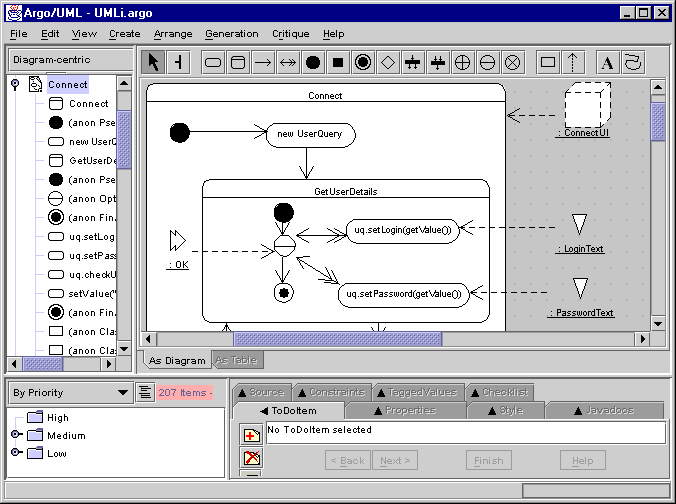UMLi and ARGOi: A Short Tutorial
1. Introduction
UMLi is a modelling language that extends UML providing the following additional facilities for user interface design:- a new diagram for modelling UI presentations called a user interface diagram.
-
Each user interface diagram is composed of one FreeContainer
 that is a top-level "window";
that is a top-level "window"; - FreeContainers may contain Containers , Editors , Displayers , Inputters and ActionInvokers;
-
Displayers
 are responsible for sending visual information to users;
are responsible for sending visual information to users; -
Inputters
 are responsible for receiving information from users;
are responsible for receiving information from users; -
Editors
 are simultaneously Displayers and Inputters;
are simultaneously Displayers and Inputters; -
ActionInvokers
 are responsible for receiving information from users in the form of events;
are responsible for receiving information from users in the form of events; -
Containers
 may contain other Containers, Editors, Displayers, Inputters and Action
Invokers;
may contain other Containers, Editors, Displayers, Inputters and Action
Invokers; - The user interface diagram constructors are InteractionClasses that are specialised UML Classes. The instances of these InteractiveClasses are the interaction objects (or widgets).

- a new set of activity diagram constructors for modelling UI behaviour:
- new activity diagram PseudoStates for modelling common UI behaviour called selection states;
- new stereotypes for modelling object flows of UI objects. These stereotypes identify the interaction object flows and they are responsible for specifying the collaboration:
- among interaction objects, and
- between interaction objects and objects from the domain.

The following screen snapshots in this tutorial may clarify the purpose of each one of these new constructors on the design of UIs. These screen snapshots were produced using ARGOi, a design environment that supports the construction of UMLi models. ARGOi is an extended version of ArgoUML. ARGOi is freely available here. Being a conservative extension of UML, UMLi, in principle, could be implemented in any UML-based design environment.
If you don't have experience with UML tools, we suggest a visit to the ArgoUML site, and in particular to its tutorial, to learn more about a standard UML-based design environment . From there, we suggest a visit to the rest of this tutorial which is organised as follows.
Concerning the modelling of UI presentations:
Concerning the modelling of UI behaviour: